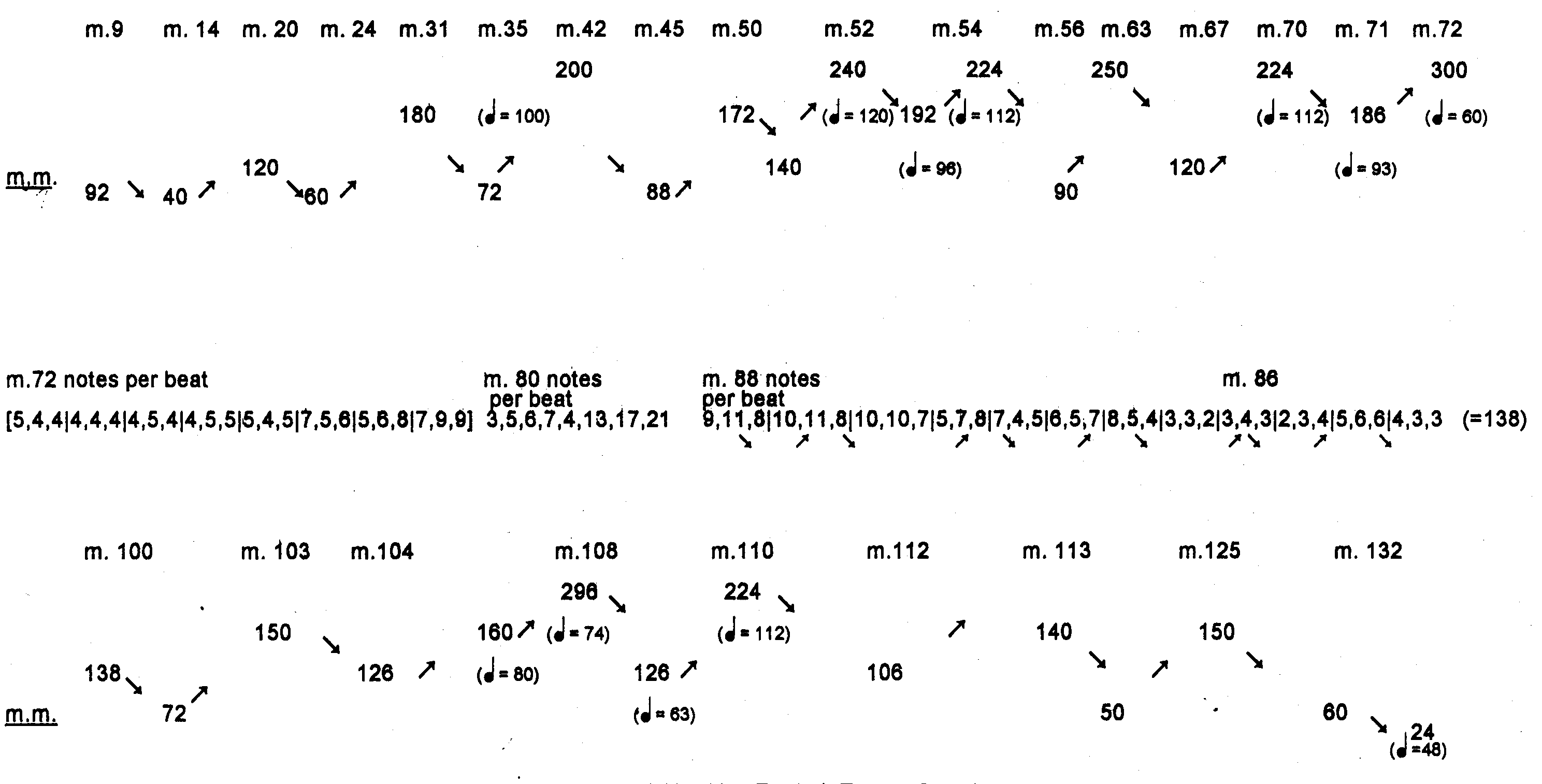
Three Études for Two Pianos (1974) by John Hawkins and String Quartet (1994) by John Burke
Bruce Mather
Following his commissioned work for the Toronto Symphony Orchestra Prélude and Prayer (1979), he underwent a radical change in style. Many composers in our century have made such a sudden change, the most celebrated being Stravinsky who, soon after his ballets Petroushka and the Rite of Spring produced his Symphonies of Wind Instruments, one of the finest of his so-called "neoclassical" works. Forty years ago it was fashionable to say that Stravinsky wrote nothing worthwhile after the Rite of Spring but few people would make such a statement now. We see that the Symphonies of Wind Instruments is just as much a masterpiece as the Rite of Spring. However, it is very different. We are too close in time to make any judgment about the respective merits of the pre-1980 or post-1980 Hawkins, but I am convinced that the change, as in the case of Stravinsky, was of absolute inner necessity and that those who look more deeply than the superficial aspects of style will find the same mastery, the same composer at work.
In the summer of 1978 the Banff Centre invited a number of composers, Violet Archer, William Schuman, Oskar Morawetz, Gilles Tremblay, Serge Garant and myself to start a composition program. The sessions were organized in such a way that every teacher met with the students in group lessons. This made for some fascinating discussions among colleagues. I especially remember the comments of Serge Garant who said to his students "What you are doing is not composition but improvisation, bad improvisation because good improvisation is structured. In fact all good music is structured and involves a thought process, musical thought." To illustrate this he proceeded to analyze several 20th century masterpieces.
John Burke's String Quartet is a fine example of structured musical thought. Serge Garant, a wonderful composer, conductor and pedagogue, had great admiration for the music of John Burke and I am sure, would have approved my initiative in making this analysis.
John Hawkins Three Études for Two Pianos (1974)
Etude I represents an overlapping wave pattern both in terms of the lines in each piano and of the ever-changing tempos. In the diagram in Figure 1, the downward or upward arrows indicate the general pitch direction of the Piano I part. The other numbers indicate the speed of the pulsations, but not always the tempo. At bar 42 pulsations at 200 are expressed through es at a tempo of q = 100. The same situation applies at bars 52, 54 and from 63 to 71. At bar 42 pulsations at 300 are expressed with quintuplets at q = 60. In fact, the pulsation fluctuations in this passage follow the number of notes per beat. At bar 80, after the ultimate point of the accelerando, there is a new accelerando in which the 'tempo' increases relatively little [q = 40 to q = 72] but the number of notes per beat increases from 3 to 21.
At bar 88 starts the ritardando with a relatively stable tempo but constant changes in the number of notes per beat until the triplets of the last beat of bar 99 moves into the of the new tempo at bar 100 (q = 138). Note also at bar 105 pulsation160 (expressed with at 80), at bar 108 pulsation 296 (expressed with the x at q =74) and at the end pulsation 24 (expressed with the h at q =48).
However, for performance purposes the Piano II part must be expressed in terms of the tempos of the Piano I part. This explains the rhythmic complexity of the Piano II part.
Here is a comparison of the speed of the Piano II part to that of Piano I at specific points :
m. 9 - more than twice as slow (see Example 1)
m. 13 - the same speed,
m. 15 - more than twice as fast,
m. 17 - the same speed,
m. 19 - twice as slow,
m. 42 - about the same speed,
m. 46 - twice as slow,
m. 53 - about the same speed,
m. 56 - three notes against 4 in Piano I.

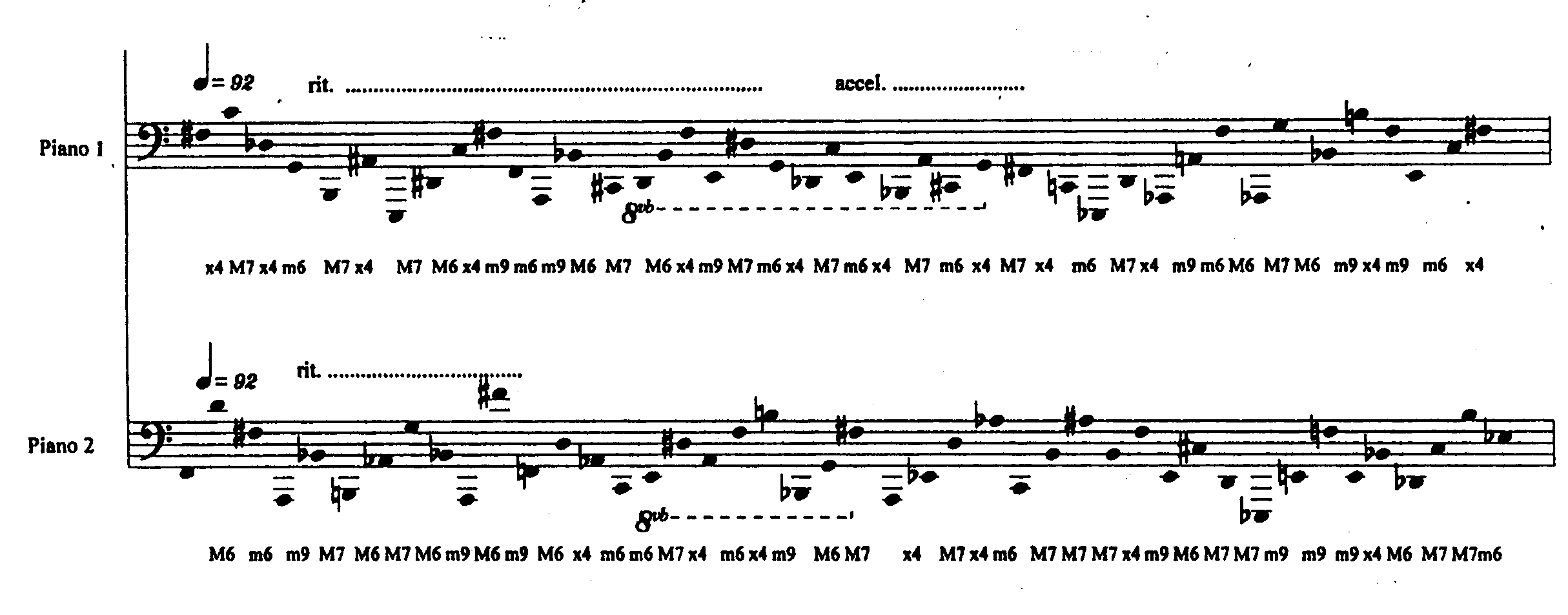
Figure 2: Étude I, Pitch Contours of mm. 1 - 9 in Piano I and II
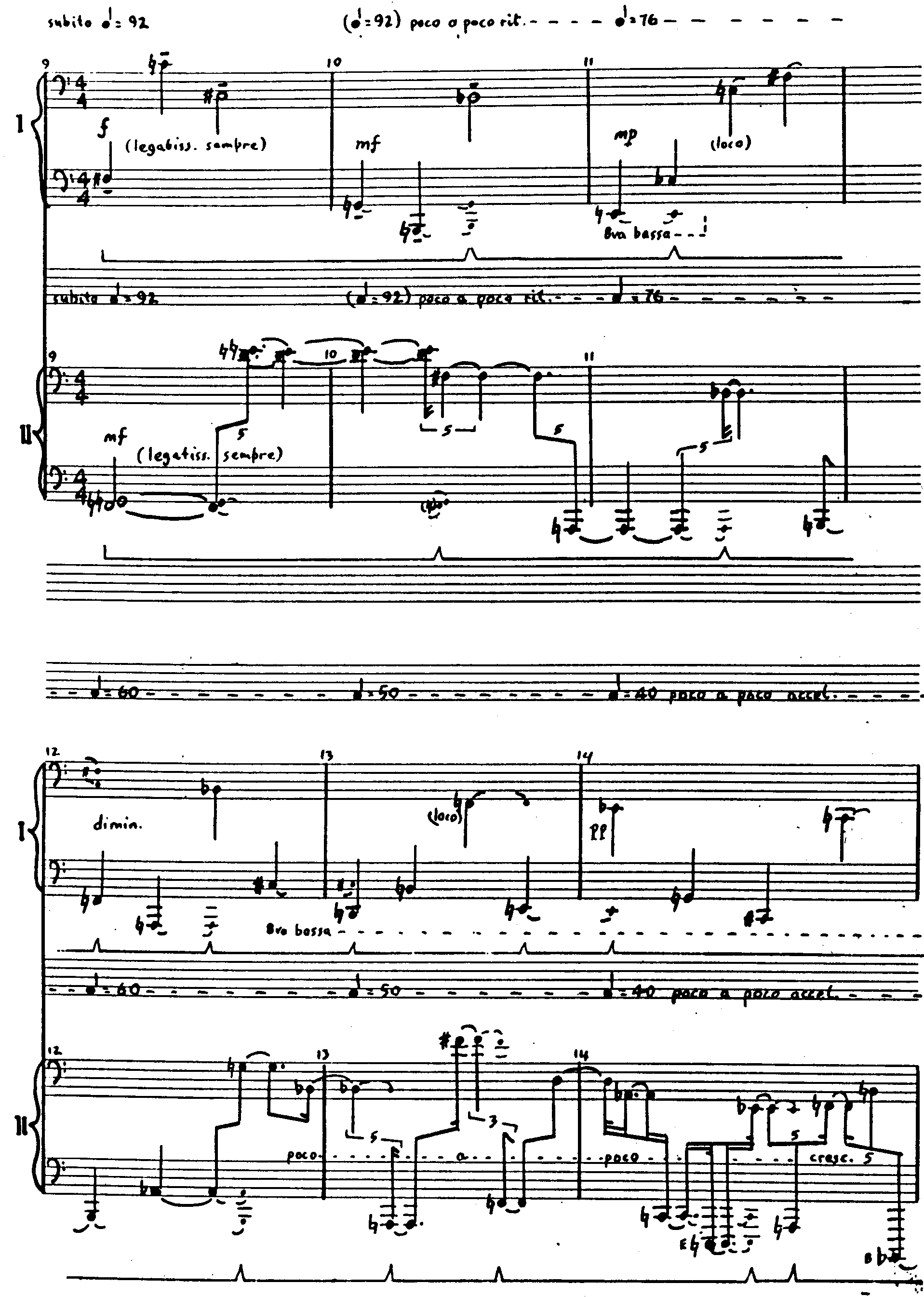
The static second étude constitutes, perhaps, Hawkins' answer to minimalism. Somehow its character suggests to me neo-classic Stravinsky as well.
The static nature is evident in the 12 fixed pitches. In close formation these symmetrical groups of 3 pitches are shown in Figure 3. Each piano has a group with a m2, m3 and a group with a m3, M2 covering the chromatic notes from B to E (P1) and E to A (PII). The actual octave placement of the tied pitches is shown in Figure 4.

Figure 3: Symmetrical 3-pitch in second étude Figure 4: Octave placement of pitches groupsin second étude.
In Piano I the white notes in the high register are used for the constant eighth-note motion and the low black notes (held by the "sostenuto" pedal) are used for accents. In Piano II the registers are "inversed" (see Example 2). There is a certain polytonal effect in that the e motion of the Piano I suggests C major and the e motion of Piano II suggests G major. In fact the six pitches in the high register give six notes of the C major scale (C,D,E,G,A,B) and the six pitches in the low register give the corresponding notes of the G major scale (G, A, B, D,E,F).
The e motion of Piano I, using only B, C, and D, is presented as an ostinato of 14 three-note chords, all different. The various arrangement in 3 octaves, high, middle and low can be analyzed in 5 categories as follows (see Figure 5).
register chord numbers
high, middle low 1, 2, 3, 4, 10, 11
two middle, one low 5, 6, 7
one middle, two 8, 13
three low 9
one high, two low 12, 14
From this we can see that the low octave is always present, the middle octave appears in eleven chords and the high octave in only eight chords.
In the e motion of Piano II the ostinato consists of 13 three-note chords (Figure 5). The arrangements of the three pitches, F, G and A, can be shown follows:
register chord numbers
high middle low 3, 8, 19, 11,12
two middle, one low 1, 2. 13
one middle. two low 4, 5, 6
one high, two low 7
two high one middle 9
Piano I is in a 3/8 metre and Piano I is in a 4/8 meter with an accent in the downbeat in each case. The e motion is interrupted by pauses that create 15 sections of varying lengths, some short [3, 4, 5, 6, 7, 8 es] some of moderate length [13, 15, 16 es] and some very long [23, 24 es]. Three sections last 15 es, two last 13 es and two, 16 es. The durations of the sections are taken from multiples of 3, i.e. 3, 6, 15, 24, from multiples of 4 i.e. 4, 8, 16, 24, and from several prime numbers [5, 7, 13, 23].

Figure 5: Pitch-register arrangements in Étude II.


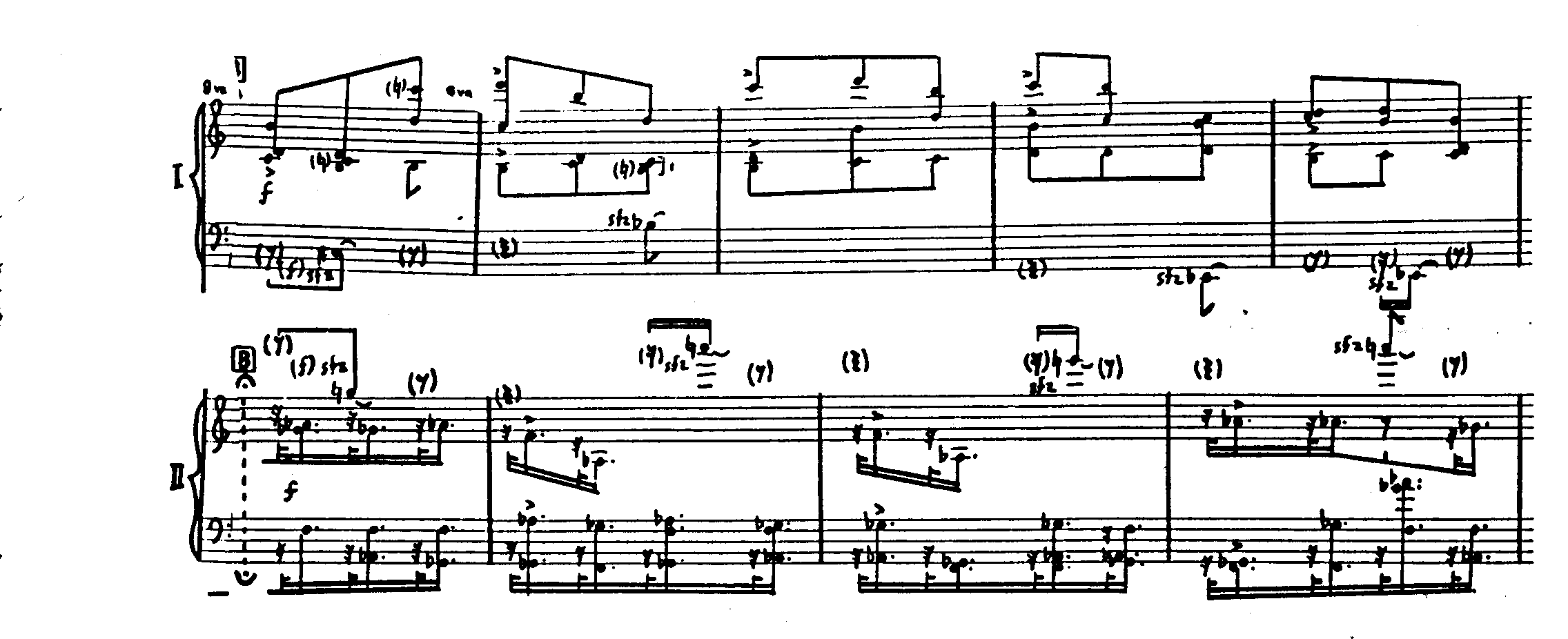
Example 2:
The attacks of the two pianos for the motion are simultaneous in the first
section in sections A, E, and N], second attack off-beat [![]() as in D, Land M] second attack near the beginning of the beat (
as in D, Land M] second attack near the beginning of the beat (![]() or
or ![]() as in section B, F, H and K) or near
the end of the beat [
as in section B, F, H and K) or near
the end of the beat [ ![]() or
or![]() ] (as in sections C, G, I and J).
] (as in sections C, G, I and J).
Figure 6 shows the successive durations and attack patterns of the 15 sections.
The accents appear in groups of two (from Pi to PII or the inverse) and can be (like the motion
simultaneous or spaced at various time gaps. Figure 7 shows the number of accent groups and
the various time gaps between the 2 notes in the 15 sections. Figures 8a and b respectively
show the accents as they appear in section B and G.


Étude III opposes 'cluster' chords of seven notes and a legato line in tempo
relationships, mostly of 3:4, 3:5, 4:5 and later in more complex relationships like 7:4. As can be seen from the tempo plan (Figure 9) sixteen different tempos are used, from
e=
40.32 to
e = 224 Two pulsations are always present (at least until m. 83). The tempo of
reference is in brackets. This always represents the pulsation of the 'clusters'.
Thus at the beginning the 'clusters' of Piano I move at the tempo
e = 126.
The legato line of Piano II moves at the speed of 5
e s
![]() i.e. 4 notes against
5 clusters. Thus the actual tempo of Piano II is 4/5 x 126 = 100.8.
i.e. 4 notes against
5 clusters. Thus the actual tempo of Piano II is 4/5 x 126 = 100.8.
At m. 12, Piano II takes over the clusters (still at tempo q = 126) and Piano I has the line moving at 3 notes against 5 clusters giving an actual tempo of 3/5 x 126 = 76.6. Also at m. 12 Piano I plays 4 notes (expressed in e.) against the 3 q of Piano II giving a resultant tempo of 4/3 x 126 = 76.6 (see Example 3.)
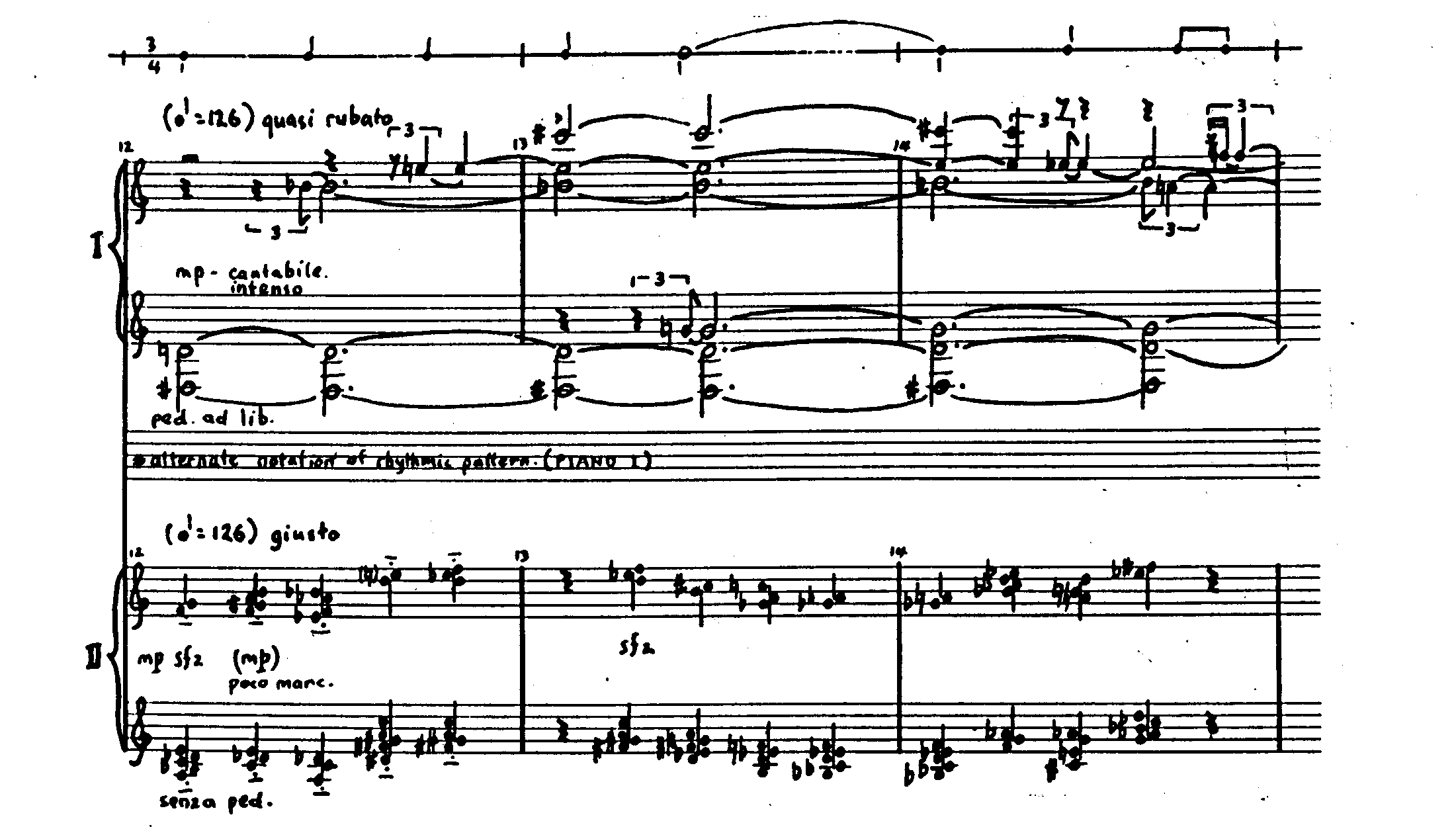
Example 3: Measure 12 of Étude III
At m. 23 Piano I plays 4 notes (expressed in e.) against the 3 q of Piano II giving a resultant tempo of 4/3 x 126 = 168. In m. 32 the clusters take over this new tempo of 168 and the legato line has 4 notes (in e.) against 3 clusters giving a tempo of 4/3 x 168 = 224.
At m. 42 the clusters adopt this fast tempo (224) but the line opposes 4 notes to 5 clusters and soon thereafter 3 notes, giving a tempo of 3/5 x 224 = 134.4 (m. 43). Note the transition in bar 50 with values of 5 x in Piano I which introduce the new tempo in m. 51 (q = 179.2 creating a pulsation relationship of 4:3, Piano II then expressing the tempo of 134.4 which is established at m. 53.
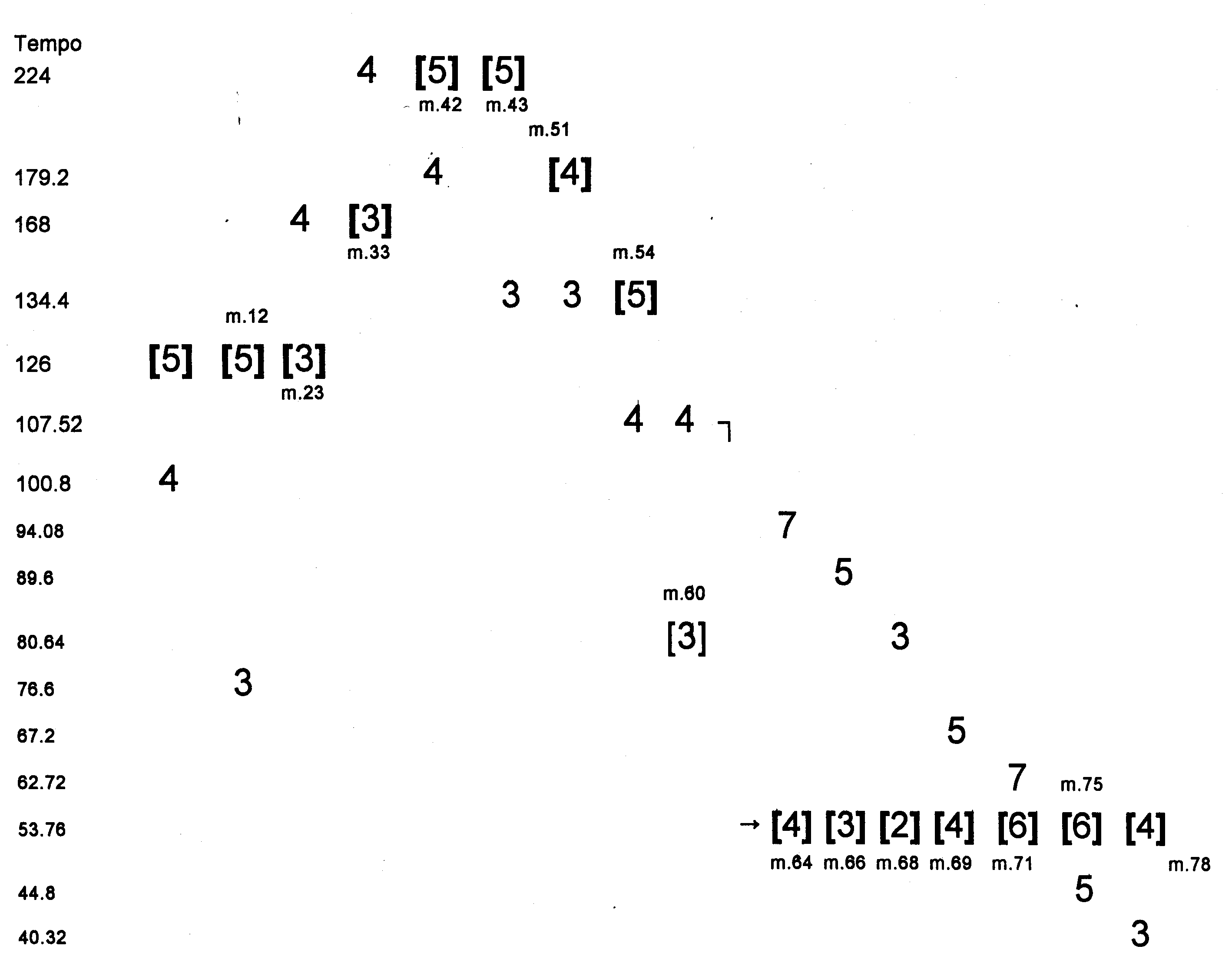
Figure 9: Tempo Plan of Étude III
Again in m. 59 Piano IIFrom then on the cluster pulsation is sporadic but there is a gradual rallentando in the line (7:4, 5:3, 3:2, 5:4, 7:6) and from m. 75 the line is even slower than the clusters (5:6 and then 3:4, in m. 78).
Of course, if every pulsation of the two simultaneous tempos were expressed,
the result would be dull. Hawkins has filtered out certain values. In the case of the cluster,
the result is phrases followed by a rest of one beat. To emphasize this effect, the first chord
of each phrase is the same as the last chord of the previous phrase, and it is accented. The
number of chords in each phrase can be shown as in Figure 10:

In the score Hawkins indicates on an extra line the rhythm of the superimposed tempo of the legato line. The opening tempo (q = 100.8) is presented much like the clusters, with occasional filtered values, giving a pattern of 4, 6, 1, 4, 3, 2, 5, 7 (integers from 1 to 7.)
In the tempo 76.6 at m. 12 there is subdivision of the beat giving the resultant rhythm:

Most of the patterns are of 1, 2, 3, or 4 notes [numbers in brackets]. In the tempo 168 at bar 23, the patterns are of 2, 3, 4, 2, 5 notes.


Figure 13:
Pitches
The top notes of the clusters outline a 12-tone row starting on C# (Figure 14), constructed with m2s, M3s and x4s in such a way that the last 6 notes form the retrograde inversion of the first six. The row then appears transposed down by a major second starting on B (m. 4), A (m. 8), G (m. 12), F (m. 15), E (m. 19), C# (m. 23), B (m. 32), A (m. 40), G (m. 44), F (m. 48), E (m. 51), C# (m. 55), B (m. 60).


Figure 15: 7-note Clusters in Étude III
The register plan of the clusters (Figure 16), which move up and down in a wave motion, shows a slight descent in the middle register (to measure 13) followed by a more rapid ascent to m. 42 and then a rapid descent to the low register at m. 66. Note the identical patterns at m. 13 and m. 21 (minor sixth down, minor ninth up, minor tenth down).
Figure 16:
As for the legato line it uses the same row as the "clusters" transposed down a semitone starting on C and then on A# (m. 4), and A (m. 9 first six notes). Thereafter the line uses mainly the m2, M3 and P4 but not in the strict order of the row.
Another aspect is the relationship of the "clusters" and the legato line in terms of register. The line has larger intervals than the "clusters" (see Figure 17). At the beginning the line is below the clusters. From bar 12 they are in the same register. From bar 33 the clusters are above the line. Then the clusters descend more rapidly and from bar 54 are below the line. From bar 68 the pitch structure becomes more static, alternating two chords, the first 6 notes of the row on G# ("x") and the last 6 notes ("y") (see Figure 18).

Figure 17: Register plan of the legato line in Étude III.

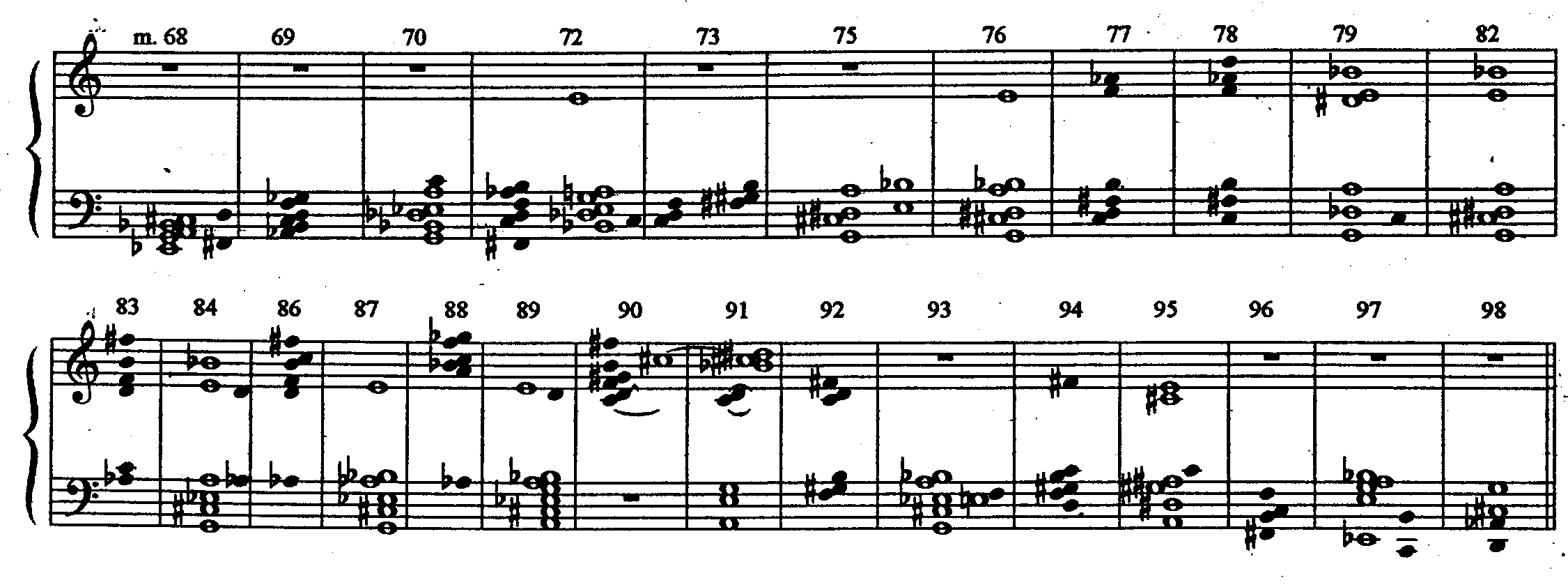
There is a subtle transition from the cluster in bar 67 (chord #9) to the same chord in bar 68 (with the D an octave higher). This chord has 5 notes of "'y" (white notes) and two notes of 'x' (black notes). In Figure 19 (verso) from measure 68 onward, I have indicated in white the notes of "y" and in black the notes of "x". I find the final section quite magical with the gradual rallentando of the legato line, finishing in bar 81, and the imperceptible transition from the clusters to the chords "x" and "y".
Chord "y" is presented in various dispositions in terms of register, range and intervallic arrangement. Very often the bass note is G (mm. 70, 75, 76, 79, 82, 84, 87, 93). The tritones are displayed in mm. 75, 76, 79, 82, 84, 87. The diminished 7th chord, formed of 2 tritones (G-D, B-E) is apparent in mm. 72, 95. In m. 91 there is an opposition in extreme registers of two diatonic groups (E, G, A and A#, C#, D#), both formed of m3 and M2.
String Quartet (1994): John Burke
Section 1 mm. 1 - 15
In the first 17 beats (bars
1-6) one sees a descending chromatic scale in
![]() from open strings,
first D, then A-E. The overlapping entrances (in number of descending chromatic
degrees) can be represented as follows:
from open strings,
first D, then A-E. The overlapping entrances (in number of descending chromatic
degrees) can be represented as follows:
Vln I 4 ------------- 7 --------- 15 ---------------- 22 -----------------
Vln II 2 -------- 5 ------------ 8 --------------- 22 ------------------
Vla 3 -------- 6 ---------------- 15 ----------
Vc 14 ------------------------------
In bar 5 this overlaps with another rising chromatic pattern in
![]() with successive
entries at quarter note distances in the viola, vln II, vln I, and 'cello (Example 4). At bar 8 the
rising chromatic line with entries at half note distances in vln I, vln II, viola and 'cello is
expressed with durations of 1, 2, 3, 4, 5, 6, 7, and 8 sixteenth notes. In Example 4a at bar
11 it is a pattern of 3 notes in triplets that rises chromatically. For violin I the pattern is a M2
up followed by a m2 down. The patterns of the other 3 players are slightly different
(Example 5). Bars 11 - 15 represent an accelerando by steps as follows: bar 11
with successive
entries at quarter note distances in the viola, vln II, vln I, and 'cello (Example 4). At bar 8 the
rising chromatic line with entries at half note distances in vln I, vln II, viola and 'cello is
expressed with durations of 1, 2, 3, 4, 5, 6, 7, and 8 sixteenth notes. In Example 4a at bar
11 it is a pattern of 3 notes in triplets that rises chromatically. For violin I the pattern is a M2
up followed by a m2 down. The patterns of the other 3 players are slightly different
(Example 5). Bars 11 - 15 represent an accelerando by steps as follows: bar 11
![]() ,
bar 12
,
bar 12 ![]() , bar 13
, bar 13
![]() , bars 14 and 15
, bars 14 and 15
![]() . In bar 12 the 15 sixteenth notes
are grouped 4, 3, 3, 2, 2, 1. In the violin I part each group is articulated by a dyad, the
upper notes of which rise by a M2, the lower notes by a m2 chromatically. In the 3
quintuplets of bar13 there is an internal expansion from notes 1 to 2 (m2, M2, m3) and from
notes 3 to 4 (m3, M3, P4) in the vlnI part (Example 6). In bars 14 and 15 vln I and II rise in
quarter notes by a M2 (vln I) and m2 (vln II). In the viola and 'cello parts the 3 separate
. In bar 12 the 15 sixteenth notes
are grouped 4, 3, 3, 2, 2, 1. In the violin I part each group is articulated by a dyad, the
upper notes of which rise by a M2, the lower notes by a m2 chromatically. In the 3
quintuplets of bar13 there is an internal expansion from notes 1 to 2 (m2, M2, m3) and from
notes 3 to 4 (m3, M3, P4) in the vlnI part (Example 6). In bars 14 and 15 vln I and II rise in
quarter notes by a M2 (vln I) and m2 (vln II). In the viola and 'cello parts the 3 separate

Example 4: Burke String Quartet mm. 6 - 11, vlnI
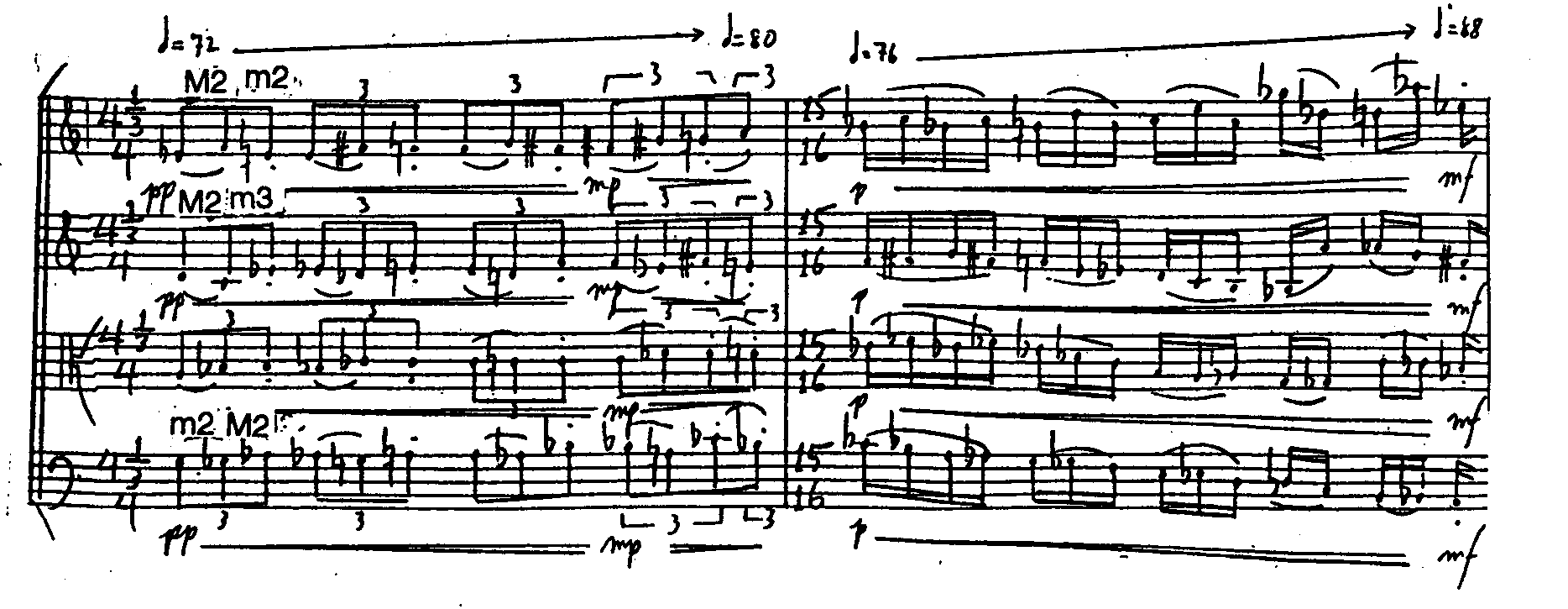
Example 5: Burke String Quartet m 11
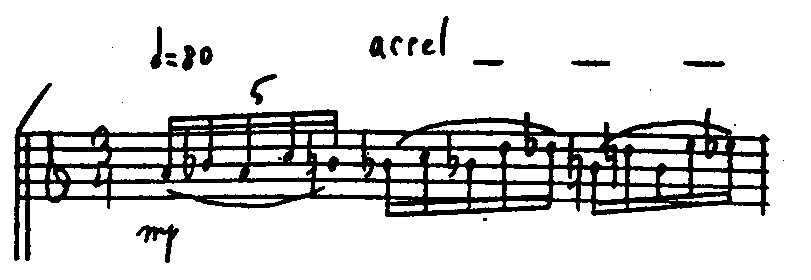
Example 6: Burke String Quartet m.13 vlnI

Example 7: Burke String Quartet mm. 14 - 15 vc

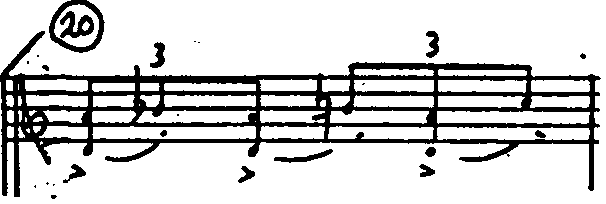
Example 8: Burke String Quartet m.19 vla, m. 20 vlnI

Example 9: Burke String Quartet mm. 34 - 35 vlnI
As at the beginning of section I, one sees a descending chromatic scale in from open strings but the total duration is shorter, 13 beats instead of 17. The overlapping entrances (in number of descending semitones) can be represented as follows:
Vln I 7 ------------ 15 ----------- 22 --------------
Vln II 8 ------------------ 22 --------------
Vla 15 ----------
Vc 13 -----------------------------------
As at bar 5 this overlaps at bar 19 with a chromatic line in , but much
longer, 18 beats instead of only 8 beats, and with a more complex line with two strands in
different registers (Figure 20).

The patterns are also different (Example 8). At bar 25 there is a descending chromatic line
(instead of the rising one at bar 8) with durations of 1, 2, 3, 4, 5, 6, 7, 8 sixteenth notes with
entries at quarter-note distances (instead of half-notes) and in the low register and close
together (Figure 21) at bar 27 starts a canon 'tremolando' with entrances at quarter note
and M2 distances in a descending chromatic line with durations of 5, 10, 11, 12, 13, 16, 15,
16 sixteenth-notes, however the first beat of each instrument is different, vlnI
![]() , vln II
, vln II
![]() , viola
, viola
![]() , and 'cello
, and 'cello
![]() .
.

Figure 21:
Section 3 mm. 39 - 74 (in 6 subsections)
(i) mm. 39 - 43. A fast descending line alternating m2 and M2 over 3 octaves in all
instruments (Example 10, m. 39) is followed in vlnII and viola with entrances at the
q and
at the P5 of a glissando descending through a P5. The glissando moves progressively
slower, the semitones having note values of 1, 2, 3, 4, 5, 6, 6, 7
e s (mm. 41 - 43). The
canon continues with 3 quintuplets rising through a circle of 5ths with upper neighbor tones in groupings of 2, 4, 3, 3, 3, notes. From m. 41 the 'cello moves in contrary motion
to the descending glissando. It rises in
![]() through a circle of 5ths with neighbor tones.
through a circle of 5ths with neighbor tones.

Example 10: Burke String Quartet mm. 39 - 43, vlnI
(ii) mm. 44 - 50. Again the two violins and viola form a canon at the q and at the P5, the material being a semitone trill in descending glissando over 8 beats followed by a descending chromatic line with M2 lower neighbor tones with an accelerando and ritardando (Example 11). At the same time the 'cello executes a slow tremolando glissando over a M6.

(iii) mm. 50 - 53. Again the two violins and viola form a canon at the
q and P5. This time a
quintuplet rising in alternating P5s and m2nds is followed by a rising chromatic line
alternating with E natural in a gradual ritardando (Example 12). As a counterpoint in
contrary motion to this the 'cello descends in
![]() by x4 and m2 and then in a glissando
trill ever more slowly to a low C# (Example 13).
by x4 and m2 and then in a glissando
trill ever more slowly to a low C# (Example 13).

Example 12: Burke String Quartet mm. 50 - 53, vlnI

Example 13: Burke String Quartet mm. 50 - 53, vc
(iv) mm. 53 - 60. Here the canon at the
q
and P5 involves all 4 instruments. After two
sextuplets descending and rising in m2 and x4 there is a trill in glissandi down a P5 over 8
beats (as in ii) followed by a descending chromatic quintuplet in M2 and m2 with a rising
glissando in rallentando and then another one in accelerando (Example 14).

Example 14: Burke String Quartet mm. 53 - 61, vlnI
(v) mm 61 - 63. Another canon at the q and P5 starts with 3 sextuplets descending and rising in m2nds and x4ths followed by a complex rhythm in ritardando over the same pitches (Example 15).

Example 15: Burke String Quartet mm. 61 - 63 vlnI
(vi) mm. 64 - 66. Another canon at the
q and P5 starts with 2 quintuplets rising in m2nd and
M2nds followed by an alternation of trills descending chromatically in
![]() and harmonics rising by m2 and M2 in alternation. The trills are grouped 5,4,3,2,1,1,1 and the
harmonics have the following durations in triplets of quarter notes: 2, 3, 4, 5, 6, 7, 8.
and harmonics rising by m2 and M2 in alternation. The trills are grouped 5,4,3,2,1,1,1 and the
harmonics have the following durations in triplets of quarter notes: 2, 3, 4, 5, 6, 7, 8.
Section 4 mm. 75 - 97
This descending chromatic scale from A to C is transformed into a pattern of a P5 with appogiatura (D, C/ A, G) by isolating notes 8, 9, 1, 2, in an ostinato (Example 16). This pattern rises through seven perfect fifths to a high F# (m. 82), then descends similarly to another ostinato of a perfect fifth with appogiaturas (F, G/ C, D) in sextuplets with groupings of 7, 7, 4, 10, 15 notes (Example 17). This leads to a development of the same pattern in 5 phrases of 1, 2, 2, 2, and 3 bars (mm. 87 - 97). These phrases, usingVln I 4 --------- 7 ------------
Vln II 2 ---------- 5 --------- 8 --------
Vla 3 ------------ 6 ------------14----------
Vc 13 --------

Example 16: Burke String Quartet mm. 78 - 81 vc

Example 17: Burke String Quartet mm. 83 -87 vc

Example 18: Burke String Quartet mm. 88 - 90 vc
Section 5 mm. 98 - 124 (in 7 subsections)
(i) mm. 98 - 105 The triplet patterns here resemble closely those of m. 11. Each instrument has a slightly different pattern (Example 19). The patterns are transposed by rising semi-tones to form 6 phrases of 3, 3, 4, 5, 6, and 7q s as shown in the case of vlnI in Figure 22.
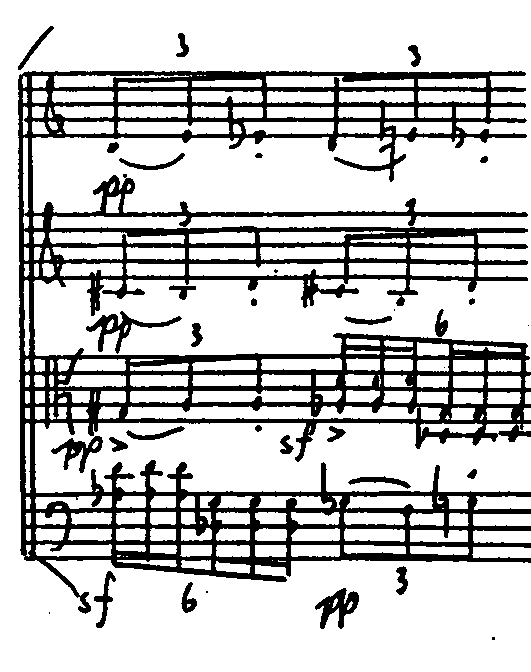
Example 19: Burke String Quartet m. 98

Example 20: Burke String Quartet mm. 106 -108
The beginning of each phrase is underlined by a sextuplet figure in the 'cello and viola in m. 104
(ii) m. 106 - 108 (9 q ) First the sextuplet figure is played by all instruments (Example 20). The vlnI part rises in an irregular rhythm with ritardandi and accelerandi as well as interval expansions. The other parts descend chromatically in groups of 3 x s.
(iii) mm. 109 - 111 (7q ) After another sextuplet figure with all instruments (Example 21), vlnI
uses the same pitches as in (ii) but a perfect fifth higher and faster, mainly in
triplets of
e.
VlnII moves more slowly, mainly in
![]() and with smaller intervals. The viola (starting
on C, G, and D) and the 'cello (starting on B, F, C) alternate a pattern in quintuplets
of e s.
and with smaller intervals. The viola (starting
on C, G, and D) and the 'cello (starting on B, F, C) alternate a pattern in quintuplets
of e s.
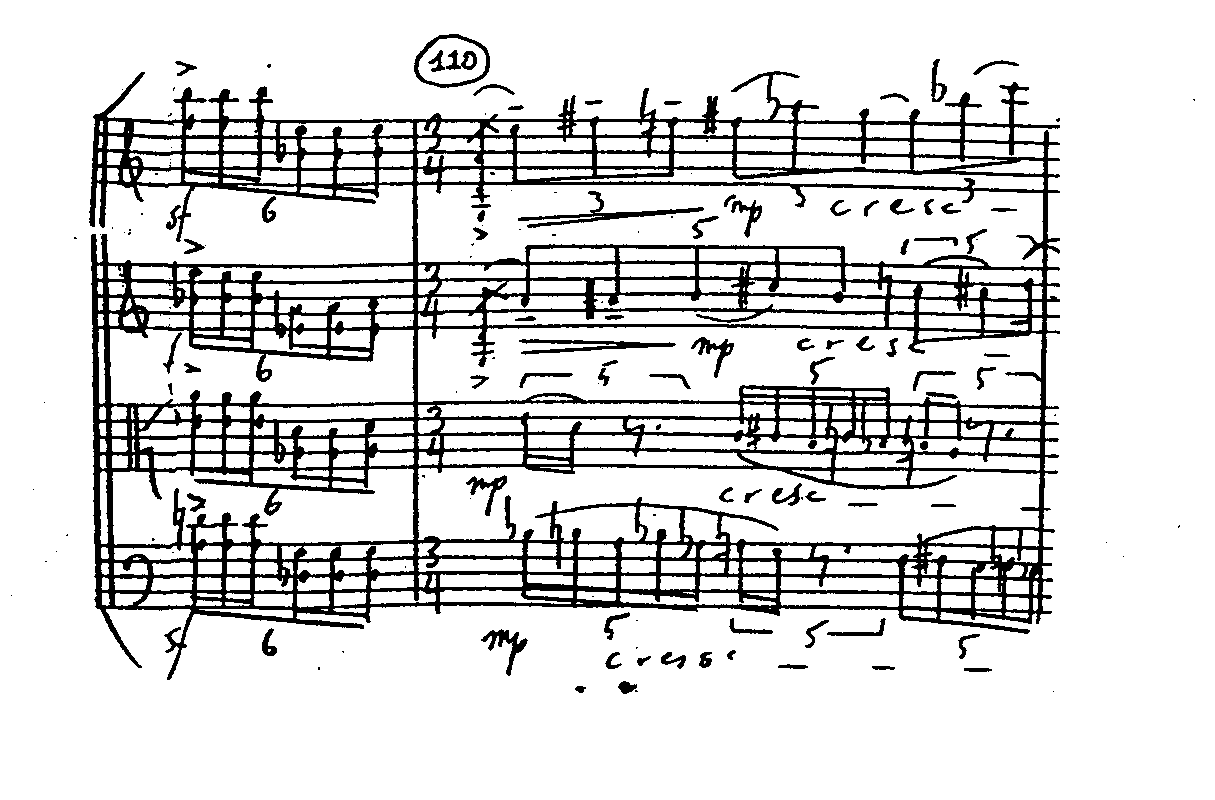
Example 21: Burke String Quartet mm. 109 - 110
(iv) mm. 112 - 113 (5
q ) After a sextuplet figure with all instruments (Example 22), vlnI rises
much as in (ii) and (iii) from B with expanding intervals (measure 113). VlnII rises mainly
chromatically from E in
![]() and the viola from A in s. In its lowest register, the 'cello
descends with a swirling chromatic ostinato in
and the viola from A in s. In its lowest register, the 'cello
descends with a swirling chromatic ostinato in
![]() .
.

(v) mm. 114 - 116 These 3 bars are identical to bars 61 - 63 except for the 'cello part which rises and descends in a circle of 5ths much as in bars 80 - 83.
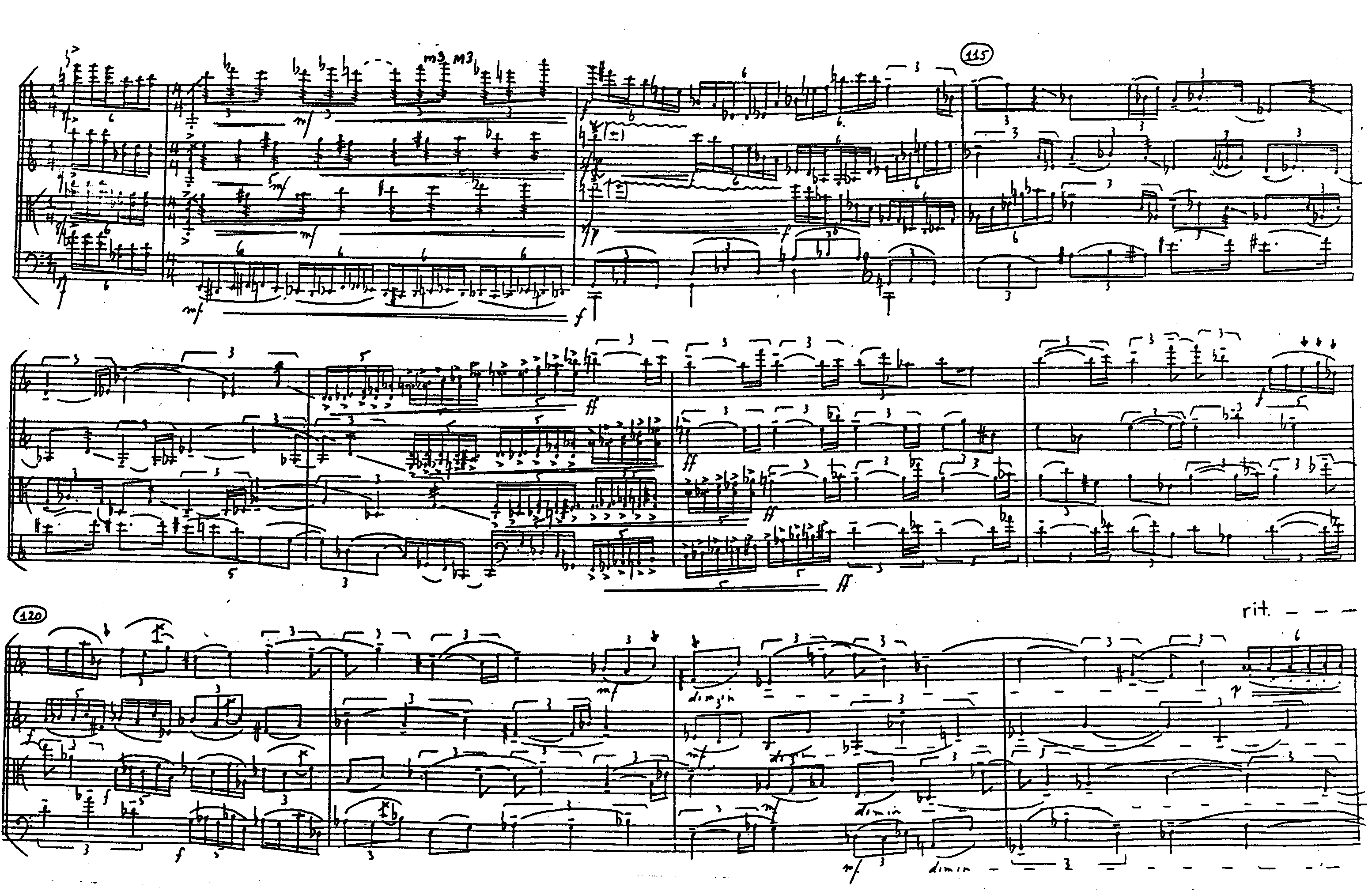
Example 22: Burke String Quartet mm. 112 - 123
(vi) mm. 117 - 119 Here all 4 instruments are in canon at the perfect fifth and q . VlnI starts with rising quintuplet double stops from D, A and E alternating m2 and M2 (much like the descending patterns of m. 56). Then it moves slowly around a diminished seventh chord.
(vii) mm. 119 - 124 Again all 4 instruments are in canon at the perfect fifth and q . A first phrase starting on E makes a rallentando around a diminished 7th chord (B, D, E, G) and a second phrase, slower, a rallentando around a diminished seventh chord a perfect fifth lower.
Section 6 mm. 125 - 157
(i) mm. 125 - 130 While the two violins and viola sustain tritones in tremolando, the 'cello alternates groups of triplets in 2 formats with fast, chromatically descending scales in sextuplets (Example 23).
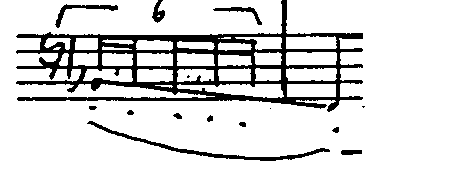
The following plan shows the numbers of triplet groups and the number of notes in sextuplets:
1 2 3 4 5
7 4 5 6 7
(ii) mm. 131 - 133 While the vlnII and viola still sustain the double-stop tritones, vlnI and 'cello in alternation play the triplet figures in a pattern of 4 + 4 + 1 (Example 24).
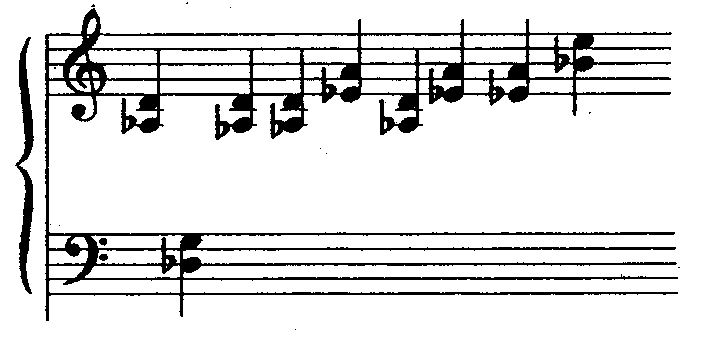
(iii) mm. 134 - 137 The pattern of two triplets and a sextuplet ![]() is
presented four times.
is
presented four times.
(iv) mm. 138 - 141 VlnII, viola and 'cello present the triplet continuously. On the 3rd beat of each bar Vln I plays the sextuplet. Note that the last beat of bar 141 is divided into 3, 4, 5, and 6 parts in 'cello, viola, vlnII and vlnI respectively.
(v) mm. 142 - 145 While vlnI and II play the triplet continuously, viola and 'cello present a "filtered" version with this rhythm: (see also Example 25):



Example 27:

The rhythmic pattern is as follows:

The 'cello starts with the sextuplet, playing it 8 times before continuing. The viola starts with the quintuplet, playing it six times before continuing. VlnII starts with the sixteenth-note group, playing it 3 times before continuing. Violin I starts the pattern with the triplet (on the third beat of bar 148). So the canon entrances are 4 q apart, in the order vlnI, vlnII, vla, vc.
(i) m. 158 The 14 s are grouped 4, 3, 3, 2, 2, starting from a unison D natural. The vlnI part moves up to a D with expanding intervals (Example 28).


(ii) mm. 159 - 160 The vlnI, vlnII, vla and 'cello parts start with
![]() ,
,
![]() ,
,
![]() ,
,
![]() respectively and all make a ritardando. The vlnI part rises with expanding intervals
(Example 28 above). The vlnII and vla have a descending chromatic pattern, the 'cello a
descending and then rising chromatic pattern. Graphically they can be represented thus:
respectively and all make a ritardando. The vlnI part rises with expanding intervals
(Example 28 above). The vlnII and vla have a descending chromatic pattern, the 'cello a
descending and then rising chromatic pattern. Graphically they can be represented thus:

(iii) mm. 161 - 162 VlnII, vla, 'cello all start with triplets slowing to
![]() ,
,
![]() and
and
![]() respectively. The vlnII part is identical to the vlnI part in m. 159 but a perfect fifth
lower. In the last 2 beats vlnI makes an accelerando . . Graphically
this phrase can be represented thus:
respectively. The vlnII part is identical to the vlnI part in m. 159 but a perfect fifth
lower. In the last 2 beats vlnI makes an accelerando . . Graphically
this phrase can be represented thus:

(iv) mm. 163 - 165 The two violins descend rapidly with alternating m2 and M2s and then
rise more slowly. In the case of vlnI, it rises with expanding intervals as in Example 28
above. The three all start with sextuplets, with
![]() vlnI slowing to
vlnI slowing to
![]() ,
,
vlnII to with an accelerando to and the viola slowing to with an accelerando to
![]() .
.
The 'cello rises in major and minor 2nds with an accelerando from to . Graphically this phrase can be represented thus:

(v) mm. 166 - 167 Here all players start at a unison D and rise as if in an opening fan:
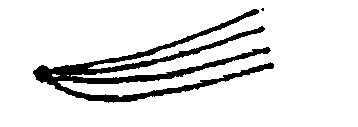
(vi) mm. 168 - 170 Here vlnI rises in quarters with expanding intervals from D to E three octaves higher (Example 30). The three other players rise four and a half octaves in sextuplets and major and minor seconds in overlapping entrances, the vla and 'cello a m6th apart, and the vln ii and viola a m3rd apart. Then they descend rapidly by m2 and x4, the vlnII in
e s, the vla in
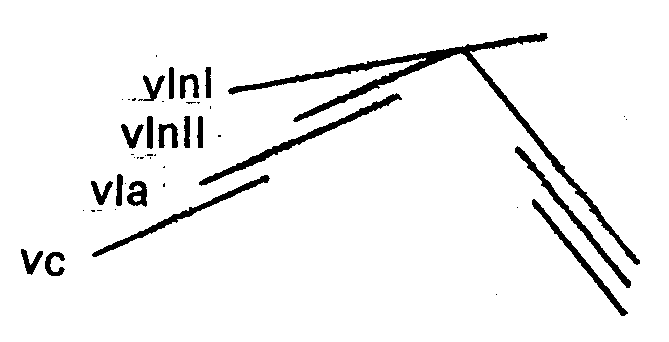
(vii) mm. 171 - 177 VlnI moves in m2nds and x4ths down to a pitch ostinato on G-A-D- E
(Example 30). Rhythmically there is an accelerando from
![]() to
to
![]() followed
by a ritardando back to
followed
by a ritardando back to
![]() . The other instruments all have ostinatos on m2nds and
x4ths that overlap on section 8, vlnII ending in m. 184, the viola in m. 185 and 'cello in m.
187. VlnII, viola and 'cello start with
. The other instruments all have ostinatos on m2nds and
x4ths that overlap on section 8, vlnII ending in m. 184, the viola in m. 185 and 'cello in m.
187. VlnII, viola and 'cello start with
![]() , and
, and
![]() respectively
respectively
![]() . They all
make an accelerando to
. They all
make an accelerando to
![]() followed by a ritardando to whole notes (see Figure 24).
followed by a ritardando to whole notes (see Figure 24).

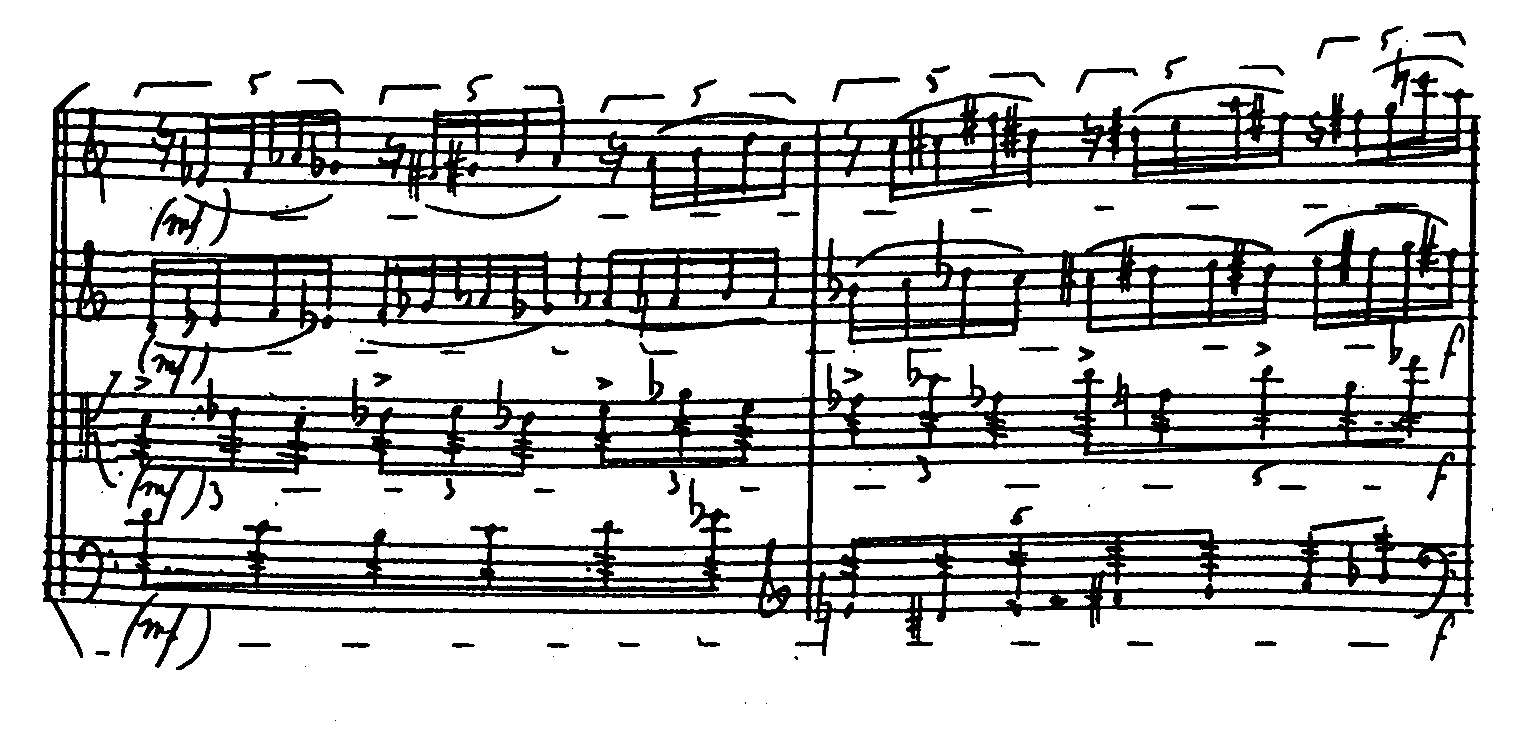

Example 30: Burke String Quartet mm. 168 -177 vlnI

Example 31: Burke String Quartet mm. 179 - 180 vlnI
Section 8 mm. 178 - 191
This section is very similar to section 6 with a violin solo instead of a 'cello solo. The violin solo is built from a triplet with x4th double stops and a descending quintuplet in major and minor seconds. The following scheme indicates the number of triplets (see Example 31 above):

At bar 184 the triplets have a different pattern and are grouped 3 + 3 + 1 + 2 + 2 + 2 + 2 (Example 32). From bar 188 vlnII plays a two-beat pattern of triplets (Example 33) with the addition of the violin the next bar and the 'cello in the following bar. Meanwhile vlnI plays a descending glissando sextuplet on every fourth beat. Note the fourth beat of m. 190, divided in 6, 5, 4, 2, 3 parts as in m. 141.


Section 9 (Recapitulation) mm. 192 - 234
Bars 192 to 196 are identical to bars 1 - 5. Then, starting on the second beat of 196 in the viola is a triplet figure in a rising circle of 5ths (Example 34). From m. 199 to 230 is a long canon at the fifth and at the q in the vlnI, vlnII, viola and 'cello.
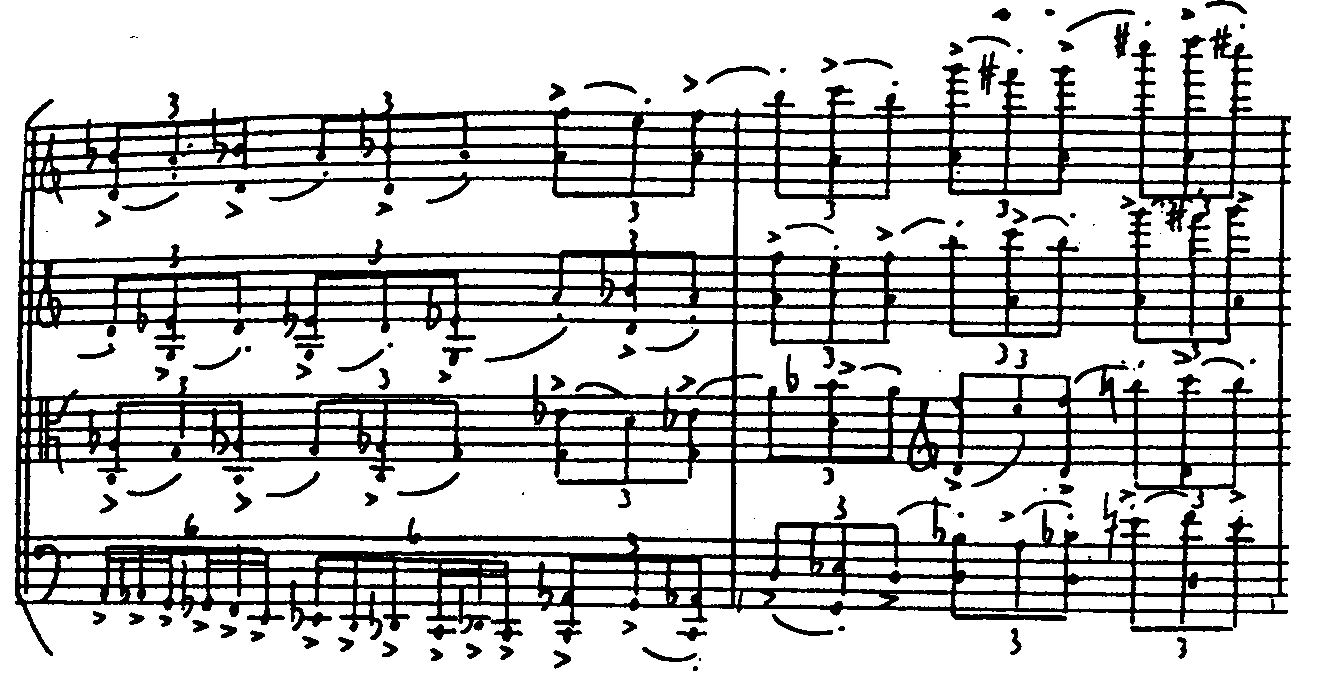
Example 34: Burke String Quartet mm. 197 - 198
At m. 199 the descending chromatic line (as opposed to the rising one in m. 8) has note values of 1, 2, 3, 4, 5, 6, 7, 8 x s except that the vlnII and 'cello have the retrograde rhythm. Starting on beat two of m. 201 and for eight beats in toto, the material is identical to the passage starting on beat of bar 61. The transitional passage starting on beat 2 of m. 203 rises first in a circle of 5ths (D. A. E. B) and then proceeds chromatically as in an opening fan pattern up to F# from B down to F (Example 35).

Example 35: Burke String Quartet mm. 203 - 205
From the second beat of m. 205 and for the next six bars the passage is identical to that starting on the fourth beat of m. 117 except that it is transposed a perfect fifth higher. From the second beat of m. 211 until m. 226 there is a succession of descending scales in major and minor seconds of six or five notes in various speeds. The notes of departure are organized in a circle of 5ths pattern. In Figure 25 one observes the notes of departure and the note values expressed in triplet e s, and then from the third beat of m. 223 in actual note values. The progressive ritardando from
At bar 231 the vlnI rises in alternating m2nd and x4ths in a ritardando
(Example 36). At the same time the other instruments play sextuplets in double stops
arranged in 3+3 or 2+2+2. The vlnII has 6 beats of 3+3 and 2 beats of 2+2+2. The pattern
in the viola is 5 q + 3
q and in the 'cello 4
q + 4
q . At bar 233 all instruments start with
sextuplets and one after another make a ritardando to
![]() .
.
Example 36: Burke String Quartet mm. 231 - 232

Section 10 (Coda) mm. 235 - 252
(i) at bar 235 the rhythmic pattern is
instead of
(ii) at bar 245 the ostinato
is repeated 7 times (instead of 3)
(iii) at bar 252 the rhythm is
instead of
Conclusion
What are the elements of musical thought revealed by these analyses? Virtually all the pitch organization consists of rising or descending chromatic scales or patterns transposed by chromatic steps, or scales alternating semitones or whole-tones or circles of 5ths or 4th or alternations of P5ths and m2nds as well as the principle of interval expansion.
The same stepwise ideas can be seen in rhythmic organizations either as a gradual lengthening or shortening or note values or of division of the beat into 2, 3, 4, 5, or 6 parts. The most traditional aspect of the work is certainly the extensive use of the strict canons, usually at the P5th and the q as can be seen in sections 2, 3, 5, 6, 7, 9 and 10.
1. - RCI 464 - single disk.